Blood, vomit, alcohol and adrenaline… there’s no better way to describe one of the most notorious theme parks in history, Action Park. In addition to having an amusement park of unsafe rides, it was full of drunk guests and managed by a team of inexperienced teenagers. Ultimately, Action Park was a recipe for disaster that resulted in thousands of injuries and six deaths. This article details all the reasons why Action Park earned the title of “the world’s most dangerous amusement park.”
Table of Contents[Hide][Show]
- A Brief History Of Action Park And How It Earned Its Reputation For Injuries & Death
Why Action Park Was The Most Dangerous Amusement Park In The World+−
- Cannonball Loop: The Infamous Action Park Loop Slide
- The Tidal Wave Pool (aka “The Grave Pool”)
- The Kayak Experience At Action Park
- Alpine Slide
- The Tarzan Swing
- Skateboard Park
- Roaring Rapids: The Gauley & Thunder Run
- Aqua Skoot
- The Aerodium
- Bumper Boats
- Super Speedboats
- Colorado River Ride
- Diving Cliffs
- Super Go-Karts
- LOLA Cars
- Geronimo Falls
- Cannonball Falls Waterslide
- Rollin’ On The River Ride (aka “The Toilet Bowl”)
- Surf Hill
- The Serpentine
- Battle Action Tanks
- The Ball Pit
- Action Park Guests
- The Action Park Staff
- Action Park First-Aid Center
- Action Park Deaths: How Many People Died In Action Park?
- Who Designed These Dangerous Action Park Rides?
- The Legacy Of The World’s Most Dangerous Amusement Park
- Have You Been To Action Park?
A Brief History Of Action Park And How It Earned Its Reputation For Injuries & Death
Before I go through what made Action Park so dangerous, it might be helpful to know a brief history of the park and how it started.
In 1976, the owners of the Vernon Valley Recreation Association, operators of the Vernon Valley/Great Gorge ski resort, began brainstorming ideas that would help them generate revenue during the summer months. Other ski reports across the United States had found success by adding summer theme park attractions and Vernon Valley decided to follow their example. In addition to building an Alpine Slide in 1976, the owners also added water slides and a go-kart track in 1978 to the Great Gorge ski area. The strategy worked and the park began growing their attractions resulting in a large and profitable summer audience.
By the early 1980s, the newly named Action Park was one of the busiest and most famous water parks in the United States. In its heyday, Action Park hosted 20,000+ people a weekend. With 75 rides, including 40 water slides and 32 motorized attractions, the park was quickly becoming a premiere entertainment destination for residents in the New York City Metro area.
As the park’s popularity and size increased, its focus on safety did not. Every season, there were a lot of injuries at Action Park. According to reports, about 100+ people per summer left the park wounded. It was so bad that Action Park had to purchase extra ambulances for the township of Vernon, New Jersey, so nearby hospitals could keep up with the volume of new patients.
Then in the summer of 1980, the park experienced its first death after a rider fell off the Alpine Slide. Over the years, more people would lose their lives at Action Park by drowning, electrocution and heart attack. In total, there were six Action Park deaths between 1978 and 1996.
But despite the injuries, deaths and lawsuits, the park still continued to thrive. Action Park almost seemed to embrace its ride-at-your-own-risk reputation and biting nicknames like Traction Park, Accident Park, and Class Action Park. By the early 1990s, Action Park was advertising itself as the world’s largest water park with catchy slogans like “The Action never stops… at Action Park,” “Where you’re the center of the action.” and “There’s nothing in the world like Action Park.”
Ultimately, Action Park fell victim to their own bad safety record, lawsuits, and its ownership group, Great American Recreation (GAR), being found guilty of insurance fraud. In 1996, the park closed as usual after Labor Day weekend, but would never reopen. Action Park’s owners filed for bankruptcy and its assets were purchased by the Canadian resort company, Intrawest. In 1998, Action Park was reopened as Mountain Creek Waterpark. The new owners revamped the water park attractions, increased a focus on safety, and demolished Action Park’s Motorworld and Alpine Center areas.
But that wasn’t the end of Action Park, or Eugene Mulvihill, the park’s original owner. In 2010, Mulvihill was able to lead a team of investors to repurchase the park with the intent to reviving the Action Park brand. Sadly, Mulvihill died in 2012 and never got to see his son Andy, lead the reopening of Action Park in 2014. The relaunch didn’t last long. Without all the dangerous rides, Action Park no longer lived up to its reputation. The summer of 2015 would be Action Park’s final season. In 2016, the park reverted to the more family friendly brand, Mountain Creek Waterpark, the name it still operates under today.
NERD NOTE: In April 1984, a New Jersey state grand jury returned an indictment listing 110 counts of conspiracy, fraud, theft, embezzlement, forgery, tax evasion and other crimes against the Vernon Valley Recreation Association, nine associated companies and a group of executives and employees headed by Eugene Mulvihill, the corporate Chairman.
Why Action Park Was The Most Dangerous Amusement Park In The World
The original Action Park only lasted 18 years, but while it was open, it was the most notorious theme park that ever existed. Here are the most dangerous amusement park rides at Action Park and other elements that made it so parlous.
Cannonball Loop: The Infamous Action Park Loop Slide
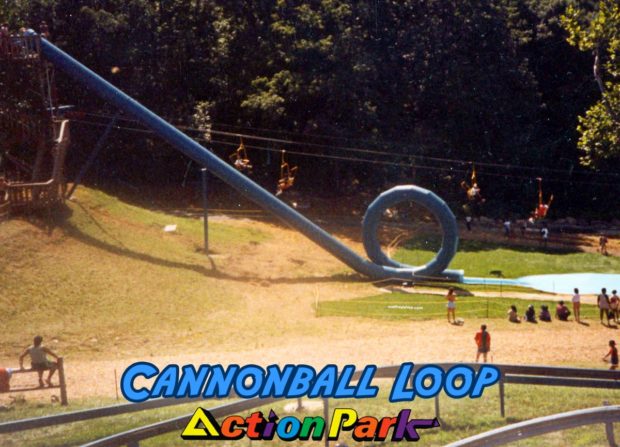
Action Park had a lot of insane and dangerous rides, but the most infamous of them all was the Cannonball Loop. This waterslide was an enclosed tube that insanely went in a complete loop.
From an engineering perspective, the Cannonball Loop looks like it was inspired by a cartoon. Because it had a full 360º loop, riders needed a lot of momentum. To help achieve the required speed, park guests would climb to the top of a tall platform where a ride attendant would then hose them down with water to help reduce friction. Riders then had to cross their arms and legs before launching down the dark tube.
Even people without claustrophobia were prone to panic on this waterslide. The Cannonball Loop was fully enclosed so riders were in a small dark tube traveling at a high rate of speed. But if a rider tried to slow themselves down, they wouldn’t have the necessary speed to complete the loop. Guests would then get smashed up in the loop resulting in concussions, broken noses and broken teeth.
Also sand and dirt would collect at the bottom of the loop and riders would get nasty abrasions and scratches all over their backs and legs.
After several riders got stuck inside the Cannonball Loop, the park had to install an escape door on the side. But even that wasn’t enough to silence critics and safety experts. The Cannonball Loop was so dangerous that it was only open to the public for one month. Due to safety concerns by the Advisory Board on Carnival Amusement Ride Safety, the infamous Action Park loop slide was closed permanently.
Even though you couldn’t ride it, the Cannonball Loop stayed standing until Action park closed for good in 1996. Unused and neglected, the ride looked like a run down relic by the mid-1990s.
Action Park’s original owner, Gene Mulvihill, had plans to build a new version of the Cannonball Loop but those efforts were abandoned after his death in 2012.
- Typical Injuries: Broken nose or teeth, concussions, abrasions
NERD NOTE: Both park employees and test dummies were used to test the Cannonball Loop before it opened to the public in 1985. After multiple test dummies emerged decapitated, Action Park’s owner, Eugene Mulvihill, offered to pay employees $100 for each time they tried the new waterslide. Adjusted for inflation, $100 in 1985 is almost $250 today. The first human to try the slide during its testing phase was Mulvihill’s son Andy, who wore hockey equipment for protection. Several employees followed his lead only to emerge covered in blood and/or missing teeth.
The Tidal Wave Pool (aka “The Grave Pool”)
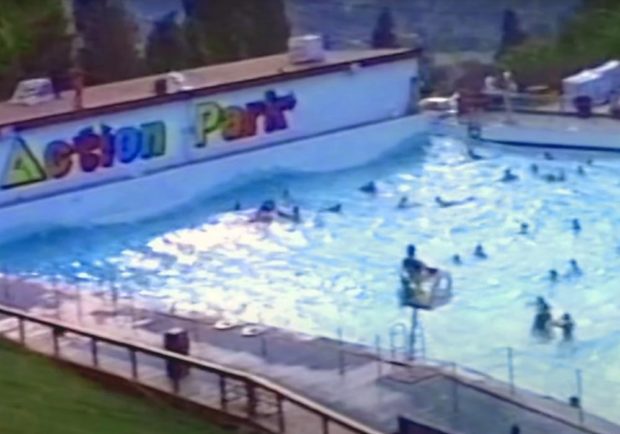
Fill up a giant pool with up to 1,000 people and generate massive tidal waves… what could go wrong? As it turns out, a lot. By far, the most deadly attraction at Action Park was the Tidal Wave Pool. Half of all the Action Park deaths took place at this location.
The Tidal Wave Pool’s waves and strong riptide were generated by massive pressure chambers. Even experienced swimmers had difficulty navigating the water. And less confident swimmers didn’t stand a chance. People attempting to wade in the shallow section were often sucked in by the riptide. It didn’t help that the pool’s floor was almost a 45º angle that funneled swimmers into the 16-foot deep end like a trap.
Panicked swimmers would also crowd around the ladders as the waves increased. This resulted in additional collisions and injuries between swimmers as they attempted to escape the water.
A dozen lifeguards had to be stationed at Action Park’s Tidal Wave Pool at all times and often conducted 20-30 rescues per day.
In total, three people downed in the Action Park Tidal Wave Pool. Between the deaths and the constant rescues, The Tidal Wave Pool was nicknamed “The Grave Pool” by park employees.
- Typical Injuries: Near drownings, concussions, bruises
- Deaths: (3)
- Drowning – July 24, 1982: 15-year-old boy
- Drowning – August 27, 1984: Donald DePass, 20-year-old from Brooklyn
- Drowning – July 19, 1987: Gregory Grandchamps, 18-year-old
The Kayak Experience At Action Park
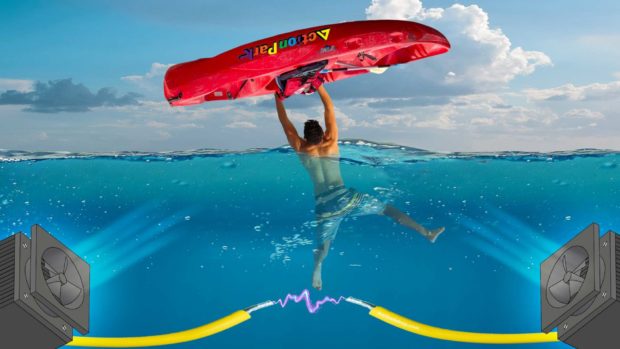
Kayaking is often a very safe and relaxing outdoor activity… but not at Action Park.
On Sunday, August 1, 1982, a 27-year-old man from Long Island was electrocuted on The Kayak Experience ride. The incident took place after his kayak got tipped over. While he was attempting to get back into his boat, he came too close to a section of exposed electrical wiring. These wires were connected to a system of underwater fans used to simulate rapids for the ride. The exposed wire caused the man to suffer a fatal electric shock-induced cardiac arrest. Several other members of his family also suffered electrical shock injuries and had to be hospitalized.
The Kayak Experience was drained and closed after the incident. When asked why, an Action Park employee told the New Jersey Herald that “people will always be intimidated by it.”
That’s right, even the mom-friendly Kayak Experience was deadly at Action Park.
- Typical Injuries: electrical shock
- Deaths: (1) Electrocution – August 1, 1982, a 27-year-old man from Long Island
Alpine Slide
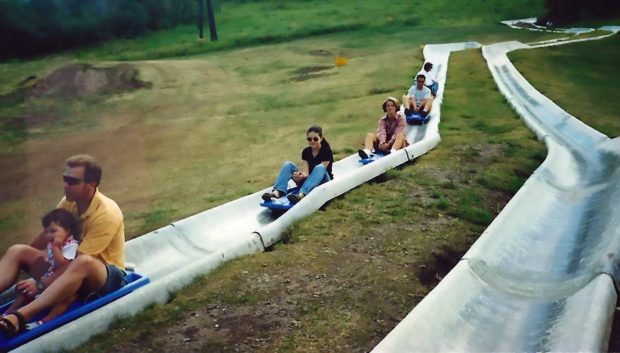
Most modern versions of an “Alpine Slide ride” involve a smooth plastic track and carefully monitored spacing between riders. The Action Park Alpine Slide had no such safety precautions. Riders would sit on a plastic sled with wheels and shoot down a steep and curved 2,700-foot long hard concrete track.
The only real effort to enforce safety on the Alpine Slide was a photo gallery of actual injuries. They were there to remind you not to go too fast or try to jump off the track on purpose.
Riders were responsible for their own balance and speed on the way down the hill. There was no guide rail or anything to prevent the sleds from shooting off the path. Staff were stationed along the track with flags and would warn you if you were going too fast. The only mechanism of control on the ride was a handbrake, that didn’t always work. Action Park’s Alpine Slide was essentially the equivalent of sitting on a skateboard and riding down a steep hill with no safety gear.
Sadly Action Park’s first fatality took place on the Alpine Slide. On July 8, 1980, George Larsson, Jr., a 19-year-old former ski lift operator at the adjacent Vernon Valley’s ski resort, died when his sled jumped the track sending his head slamming into a rock. The impact put him into a coma, and he unfortunately died a few days later. The park initially tried to hide the incident. Because Larsson was an employee at one point, the owners thought that they were not required to report his death to the state.
I grew up in New Jersey and went to Action Park a handful of times as a kid. At the time, I was too young to ride the Action Park Alpine Slide, but I wouldn’t have done it anyway. I remember seeing a woman that got hurt walking down the side of the track. I don’t know what happened, but she was limping down the hill crying, and covered in blood.
Falling off the track was a common injury for riders of the Alpine Slide. Because this was a water park, most guests were only wearing bathing suits and flip-flops. As a result, riders who fell off their sleds got extreme road rash from either the concrete track or surrounding rocks and dirt. The staff had a nickname for this type of injury, they called it an “Action Park tattoo”.
If the track wasn’t dangerous enough, riders also had to watch out for people dropping sleds on their heads. The line for the Alpine Slide started at the bottom of the hill where riders would grab a sled and get on a chairlift. The chairlift then traveled directly over the Alpine Slide track. If someone on the chairlift didn’t secure their sled properly, or they were too drunk to hold it, then their sled would come crashing down on the riders below.
Even if a rider descended the hill in a slow and controlled manner, that didn’t guarantee an injury free experience. If the rider behind you was fast and out of control, then they might slam into the back of your sled and give you whiplash.
- Typical Injuries: Road rash abrasions, lacerations, impact injuries, whiplash, loss of fingers
- Deaths: (1) Head Injury – July 8, 1980, George Larsson, Jr., a 19-year-old ski lift operator
The Tarzan Swing
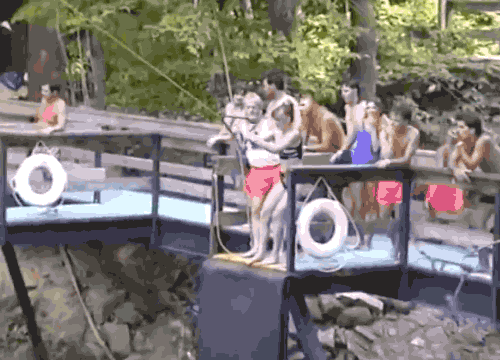
The Tarzan Swing was one of the most popular backdrops used in Action Park’s TV commercials. It featured a 20-foot-long rope that guests could use to swing into a giant 15-foot deep pool.
The Tarzan Swing provided a great people watching opportunity. In just a few minutes, you could see everything from back flips to belly flops. Another reason for the attraction’s popularity, was the tendency for people’s bathing suits to come off. Much to the amusement of onlookers, women’s bikini tops and guy’s bottoms frequently flew off as they landed into the pool.
I don’t remember my turn at the swing, but my brother did a belly flop. He exited the pool in tears while drunk onlookers cruelly laughed.
In addition to belly flop injuries, some guests would forget to let go of the rope and start swinging back towards the platform. To help prevent injuries, the park had to add padding below and around the platform. Guests who didn’t let go of the rope got slammed into the pads. Humiliated, they then had to swim back the entire length of the pool to get out while everyone watched.
Besides forgetting to let go, the Tarzan Swing doesn’t sound too dangerous, right? However, this spring feed pool was a frigid 50 ºF. Just imagine transitioning your body instantly from a warm 95º summer day to chilly 50º spring water. For some people, the temperature shock was too much to handle. Guests frequently had trouble swimming after plunging into the cold water and had to be rescued by lifeguards.
Unfortunately for one guest, the temperature shock likely cost them their life. In the summer of 1984, a park visitor suffered a fatal heart attack after using the Tarzan Swing. The attack is believed to have been triggered by the temperature shock.
1984 was a bad summer for Action Park deaths. In addition to this heart attack at The Tarzan Swing, a 20-year-old man also drowned at The Tidal Wave Pool.
- Typical Injuries: Near drownings, temperature shock
- Deaths: (1) Heart Attack – 1984
Skateboard Park
In an effort to capitalize on skateboarding’s popularity in the late 1980s, Action Park created a Skateboard Park attraction. This poorly designed concrete disaster had jagged edges and awkward angles. Even experienced skateboarders would frequently get hurt at Action Park’s Skateboard Park.
The Skateboard Park was responsible for so many injuries that the park eventually decided to bury it in dirt. One day bulldozers covered it up and the park just pretended that it never existed.
- Typical Injuries: Broken bones, concussions
Roaring Rapids: The Gauley & Thunder Run
Action Park’s Roaring Rapids was a whitewater rafting ride. The ride had two slides. The right slide was called Thunder Run and riders could use a double tube. The left side was called The Gauley and had a much more intense experience for one-person tubes. The drops and turns in The Gauley were so extreme that it was almost impossible to stay seated in your tube. And the last thing that you want to do on this ride is to lose your raft. The Roaring Rapids wasn’t designed for riders without tubes. The water was deep and the walls were very rough.
Like most the watersides at Action Park, there usually wasn’t anyone at the bottom of the ride making sure no one collided. People would fall out of their tubes and get chewed up. There were also plenty of concussions from people hitting their heads on the concrete or other people’s heads.
According to an injury report filed with the State of New Jersey, guests experienced a variety of injuries at Roaring Rapids including broken femurs, noses, and collar bones and dislocated knees and shoulders. Most of these took place on The Gauley side of the ride.
- Typical Injuries: Broken bones, dislocations, concussions, abrasions
Aqua Skoot
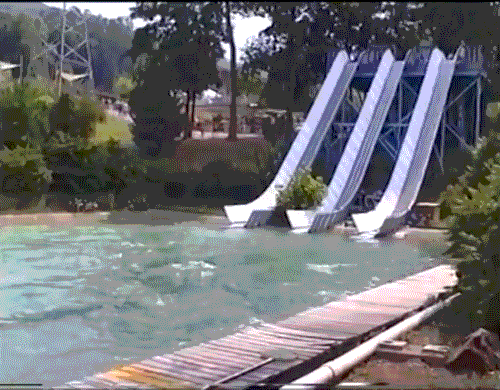
Skipping stones in a pond was likely the inspiration for the Aqua Skoot ride. Riders would carry a hard and heavy plastic sled to the top of the slide. You would then get on your sled and the ride operator would pull a level sending you over a metal path lined with assembly line rollers. The ride concluded by shooting guests down a long 30-foot steep slide into a shallow pool.
The idea was to make the sled hydroplane across the water. However, if the rider didn’t lean back just right, they would shoot face-first into the shallow water instead of gliding across.
The Aqua Skoot featured three parallel slides. If riders didn’t leave the area quick enough or stay in their lane, the next rider would crash into them potentially resulting in a whiplash injury.
- Typical Injuries: Various head and impact injuries, concussions, whiplash
The Aerodium
The Aerodium was a skydiving simulator and Action Park was the first American amusement park to have one. Guests had to wear special skydiving suits, helmets and earplugs. They would then join an instructor on a trampoline over a giant fan surrounded by stadium seating so everyone could watch. The instructor would hold the guests by their arms and position them over the fan, so they could “fly” in the air. The ride only lasted a few seconds and the instructor would cut the power once a guests reached about 6 feet (1.83 meters) into the air.
The Aerodium was responsible for several injuries at Action Park. Instead of curling up in a ball after the instructor turned off the fan, guests would intensively stick their arms out to break their fall. This sometimes resulted in guests dislocating shoulders or breaking their arms and wrists. One rider reportedly severed the nerves in their shoulder and had partial paralysis in their arm.
- Typical Injuries: Broken bones, dislocations
Bumper Boats
Yes even the Bumper Boats were dangerous at Action Park.
Since the boats were small, taller riders would frequently dangle their legs over the edge. This position might have been more comfortable, but it wasn’t safe. The other boats would smash people’s dangling ankles when they collided with your boat.
The Action Park Bumper Boats also were prone to fuel leakages. Sometimes the amount of gasoline in the water resulted in chemical burns to rider’s skin and eyes.
- Typical Injuries: Smashed and broken ankles, chemical burns, eye irritation
Super Speedboats
From the Skateboard Park to the Kayak Experience, sometimes Action Park would just buy a bunch of gear and turn it into an attraction. This was also the case with their Super Speedboats ride. Guests could take actual full-sized speedboats out for spin in an enclosed space with other speedboats. If it doesn’t sound safe, that’s because it wasn’t. Customers would race towards other boats in a game of “chicken”, try to splash each other, and even ram other boats.
According to the Class Action Park documentary, one guest actually launched their boat on top of another boat. The crash was so bad that the staff thought that the bottom driver had been decapitated. Luckily they weren’t. During all the confusion, the driver of the top boat ran off and escaped facing any potencial consequences.
And if the Super Speedboats weren’t already dangerous enough, they were also full of snakes. The staff had to fish snakes out the speedboats each morning before opening the ride. Fortunately, the snakes in the Vernon Valley area are non-venomous.
- Typical Injuries: Whiplash, snake bites
Colorado River Ride
The Colorado River Ride was Action Park’s twisted version of a “lazy river” ride. In other words, it was not relaxing and semi-dangerous.
Up to four riders would climb inside a raft and attempt to navigate water hazards, sometimes as dangerous as the Colorado River itself. Parts of the river had difficult rapids and steep drops. This sometimes resulted in riders colliding into each other or the walls.
The river also featured several caves, pools, and forks where riders would frequently get stuck and hit by other rafts. This sometimes resulted in drunken fist fights between guests, either in the river or at the end of the ride.
This is one of the few rides that is still operating today as part of Mountain Creek Water Park, but riders now have to wear helmets.
- Typical Injuries: Concussions, fist fight related injuries
Diving Cliffs
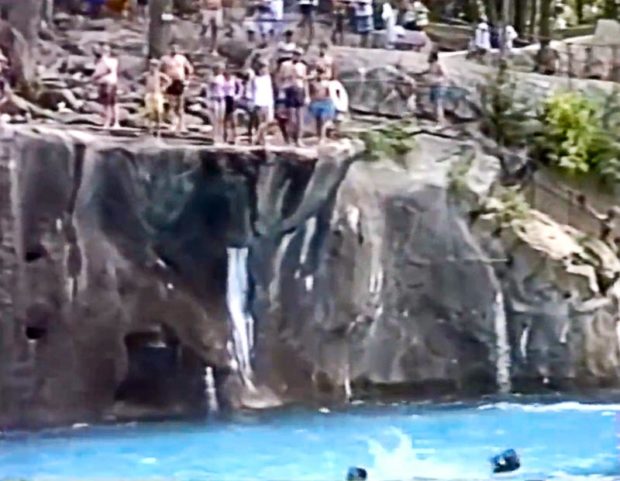
The Diving Cliffs attraction at Action Park was a rock ledge 23-feet above a 16-foot deep pool of water. There were no ropes or fences to help create an organized line. Just a cluster of people standing at the edge of a cliff.
Guests would take turns jumping into the pool and trying to avoid the often unaware swimmers below. But with usually only one lifeguard on duty, collisions were hard to prevent.
At 16-feet deep, the pool was a dark void and made it difficult for lifeguards to see if someone was below the surface. The park eventually painted the floor of the pool white for safety reasons and to increase visibility.
- Typical Injuries: Impact injuries, concussions
Super Go-Karts
For safety reasons, the Super Go-Karts at Action Park had a 20 mph (32.19 km/h) speed cap. But employees would modify the cars and remove their speed limits allowing the cars to reach speeds of 50 miles per hour (80.47 km/h). This was mostly for their own enjoyment, but the staff didn’t always re-enable the speed cap. As a result, customers would sometimes end up riding the faster super go karts cars and get hurt.
Park guests would also use the go-karts like bumper cars and purposely slam into each other. Combine this with the park’s open container policy and I’m surprised that no one died at the Super Go-Karts ride.
- Typical Injuries: Concussions, impact injuries, whiplash
LOLA Cars
The LOLA Cars were another popular ride showcased in Action Park’s TV commercials. These mini race cars were also modified by employees to go faster than they should have. One employee even reportedly took a modified LOLA car onto the adjacent highway, NJ-94.
- Typical Injuries: Impact injuries, whiplash
Geronimo Falls

The Super Speed Water Slides (aka Geronimo Falls), were two vertical water slides at Action Park. Geronimo Falls was basically a semi-controlled free fall with a hard splash landing. People came down the slide so fast that some riders even hit speeds of 60 mph (96.56 km/h).
Ride attendants had to remind guests to lean back in order to keep their bodies from floating out of the slide on the way down. The park eventually had to add a cover to the top section of the slide.
There were always a ton of horny guys at the bottom of Geronimo Falls. Most girls lost their bikini tops coming down. Guys would lose their suits too. Compounding their embarrassment, people were often so stunned after the ride that they stood up and didn’t realize that they were naked.
The ride still exists today and is called H-2-Oh-No , but it has been modified for safety. Only one of the two slides are still standing and it’s less steep than the Geronimo Falls.
- Typical Injuries: Water impact, extreme wedgies
Cannonball Falls Waterslide
The first time I went to Action Park was in the mid-1980s and my brother and I were only 12 and 10 at the time. While my dad was watching our 7-year-old sister, my brother and I got to roam the park by ourselves.
Even as tweens, we knew this park was dangerous. We were struggling to find a ride that wasn’t too scary and eventually found Cannonball Falls. A bunch of other kids our age was also in line, so we felt better.
At the time, the entrance to this waterslide was basically just a hole in the ground. I didn’t remember a staff member being nearby or even a line. We didn’t know where this slide went, so as the older sibling, I decided to go first. I climbed into the hole and immediately regretted it.
Cannonball Falls was a totally dark underground water slide. After getting tossed around in the dark, riders were then shot out 10 feet (6.1 m) into the air above a freezing pool full of water. I spun out of the hole uncontrollably and landed flat on my back in the water. The wind was immediately knocked out of me, and I was freezing. My brother’s exit was worse. He landed on his stomach and threw up in the bushes after he got out of the pool. We both had bright red torsos for the rest of the day.
As bad as we had it, the kids who went after us got it worse. The staff were not good at spacing out guests. One kid didn’t move out of the way in time and another kid landed on him. They both limped out of the pool and one of them had a bloody nose.
- Typical Injuries: Water impact injuries, concussions, having the wind knocked out of your lungs
Rollin’ On The River Ride (aka “The Toilet Bowl”)
There were multiple tube and raft rides at Action Park. For the Rollin’ On The River Ride, the park repurposed the snow tubes from their ski resort.
The water raft adventure featured several holes that plunged riders into pools of water below. Park staff didn’t strictly limit how many people could use the ride at once. As a result, human clogs were common earning the ride a nickname, “The Toilet Bowl.”
- Typical Injuries: Impact injuries
Surf Hill
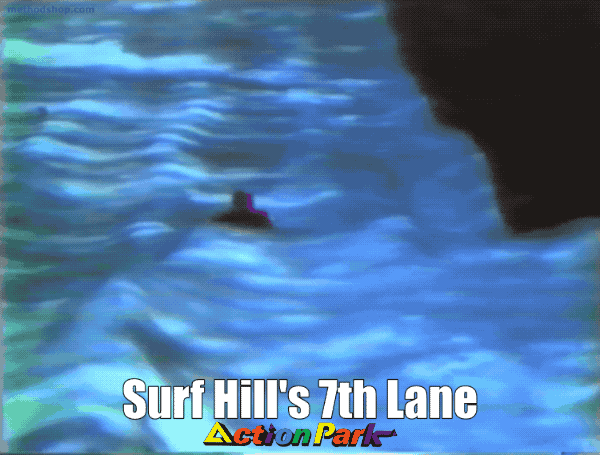
The Surf Hill ride was a favorite among staff members. Not only to ride themselves, but to watch others.
The concept behind the ride was simple, guests would grab a mat and then slide down one of eight different parallel tracks. All the tracks gave riders a thrilling run, but the 7th lane was nicknamed the “back breaker” by Action Park employees. The distinct angle of its last mogul would send riders flying several feet into the air. This resulted in higher jumps and a bigger splash into the pool at the bottom. If you look closely, the 7th lane is prominently showcased by Action Park in their TV commercials.
Most of the guests at Action Park didn’t know abut the 7th lane. But the staff did. They would frequently gather at the snack bar next to Surf Hill during their breaks. It provided a good view of the 7th lane, and they were almost guaranteed to see an injury or someone lose a bikini top.
Except for its infamous 7th lane, Surf Hill was almost safe. The other major safety issue with the ride was spacing. Riders would often jump their tracks and collide with each other towards the end of the track.
- Typical Injuries: Concussions, collision related injuries
The Serpentine
The Serpentine was one of the safer waterslides at Action Park. Guests were given a mat to use for their ride down the slide. But the staff weren’t great at spacing out riders or telling them to roll up the front of their mats. If you didn’t roll up the front part of your mat, then the extra material would create friction and slow you down.
The lifeguard at the top of The Serpentine ride didn’t tell us to roll up our mats and my brother came to a complete stop in the middle of the slide. While he was trying to push himself down, a guy slammed into him from behind sending both of them down the slide together in one ball of human flesh. Luckily they weren’t seriously hurt when they both crashed into the pool at the end of the ride together.
- Typical Injuries: Concussions, collision related injuries
Battle Action Tanks
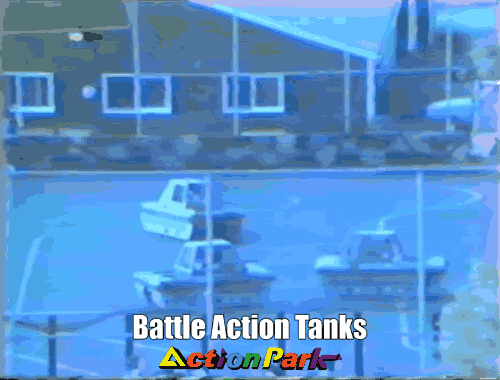
One of the most popular attractions in Action Park’s Motorland, were the Battle Action Tanks. Guests could pay an additional fee to drive motorized tanks with tennis ball cannons. There were also stationary cannons placed outside the arena that let people shoot the tanks.
Each tank had a target sensor. If a tennis ball hit a tank’s sensor, then it would spin around in circles. This resulted in more than a few riders puking inside their tanks.
Although the Battle Action Tanks attraction wasn’t overly dangerous for park guests, it was for employees. One of the worst jobs at Action Park was being part of the maintenance crew for the Battle Action Tanks. The crew frequently found themselves under fire from tennis balls by drunk and rowdy park guests.
- Typical Injuries: Bruises, vomiting
The Ball Pit
The ball pit was disgusting. There were all sorts of crap in there like straws, wet clothes and band-aids. My brother even found a dirty diaper, luckily it wasn’t a poopy one.
- Typical Injuries: Various viruses, E. coli
Action Park Guests
The park had an open-container policy and alcohol was everywhere, especially beer. Almost everyone was drunk and fights, puking, and public urination were all common on the property. If I had to guess, most Action Park injuries were probably connected to alcohol somehow. Rides like the Alpine Slide were difficult enough to navigate sober. But after a few drinks, they were almost impossible.
And when the drunks weren’t busy hurting themselves, they were usually heckling other guests and waiting for people to lose their bathing suits on rides like Tarzan Swing, Surf Hill, and Geronimo Falls.
The Action Park Staff
If you find yourself in an emergency situation at a theme park, where do you go first for help? The staff. But what if your only lifeline is a bunch of young inexperienced kids?
The average employee age at Action Park was well under 30. The park actually got in trouble at one point for letting minors operate some of the more dangerous rides.
Also, many of the staff members were from foreign countries. They would work for cheap in exchange for the opportunity to spend the summer in the United States. Not that being from a foreign country is bad. But when you need critical information, like directions to the closest hospital, most of these kids didn’t know the local area very well.
For those of us who lived it, the 1980s were a boom for recreational drug use and the young staff at Action Park were not excluded. According to reports from former employees, some staff members were drunk or high while at work. Just imagine putting your life in the hands of a teenaged lifeguard tripping on acid.
Action Park First-Aid Center
Some theme parks have state-of-the-art medical facilities and licensed nurses on staff, but not Action Park. Their “medical” team mostly consisted of inexperienced kids with limited first-aid training. Their goal was to call a Vernon Township ambulance to take you to the hospital, or patch you up for your painful ride home.
In addition to ice packs and band-aids, the first aid team also had a “healing potion.” They would spray this on road rash injuries that people got from rides like the Alpine Slide. This potion was a mix of alcohol and iodine and caused an intense burning sensation almost as bad as the original injury.
Action Park Deaths: How Many People Died In Action Park?
In total, how many people died in Action Park? Six. Park management argued that statistically, these six Action Park deaths were a very small number compared to the millions of guests who visited the park during its lifetime. Nonetheless, these six people would still be alive today if the park had a stronger focus on safety.
The Tidal Wave Pool was the most deadly ride at the park. Half of all Action Park deaths took place at that attraction.
- Head Injury at The Alpine Slide – July 8, 1980, George Larsson, Jr., a 19-year-old employee at the park’s ski resort
- Drowning at The Tidal Wave Pool – July 24, 1982: 15-year-old boy
- Electrocution at The Kayak Experience – August 1, 1982, a 27-year-old man from Long Island
- Heart Attack at The Tarzan Swing – 1984
- Drowning at The Tidal Wave Pool – August 27, 1984: Donald DePass, 20-year-old from Brooklyn
- Drowning at The Tidal Wave Pool – July 19, 1987: Gregory Grandchamps, 18-year-old
Who Designed These Dangerous Action Park Rides?
While reading about these dangerous Action Park rides and attractions, you were probably wondering who designed them? The answer: anybody and everybody. The reason many Action Park rides were so insane and unsafe, was they weren’t designed by people with engineering or theme park ride experience. It’s no wonder why there were so many action park deaths and injuries. Even the park’s custodian designed one of the rides.
The Legacy Of The World’s Most Dangerous Amusement Park
In the years since it closed, several documentaries (Class Action Park, The Most Dangerous Theme Park In America) and even a feature film, called Action Point, have been created about the dangerous rides at Action Park. Johnny Knoxville‘s character in the 2018 film, Action Point, is based on Action Park’s infamous owner, Eugene Mulvihill.
Have You Been To Action Park?
Surviving Action Park became a rite-of-passage for many members of Generation X that grew up in the New York City metropolitan area. We all knew about the Action park accidents. We all knew about how dangerous the Action Park rides were. We all knew Action Park was the world’s most most dangerous amusement park. And we still went anyway.
But what was safe in the 1980s? You could still smoke in restaurants and airplanes. Most cars still didn’t have seatbelts in the backseat. And we were all about to die anyway from the Cold War, right?
Did you visit Action Park between 1978 and 1996? What were some of your experiences? Please let us know in the comments.

Frank Wilson is a retired teacher with over 30 years of combined experience in the education, small business technology, and real estate business. He now blogs as a hobby and spends most days tinkering with old computers. Wilson is passionate about tech, enjoys fishing, and loves drinking beer.

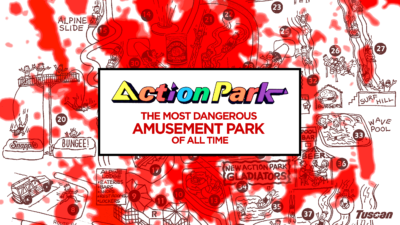
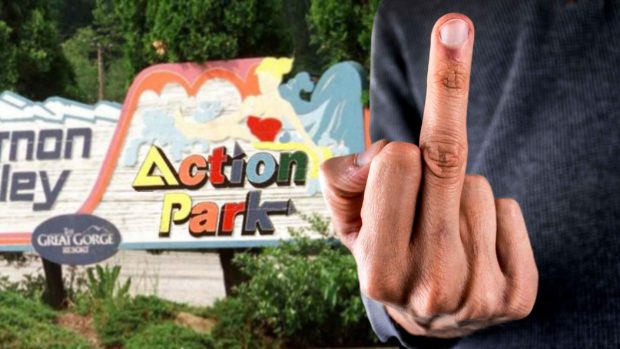












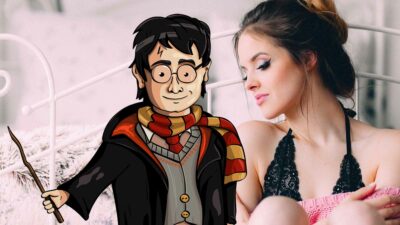






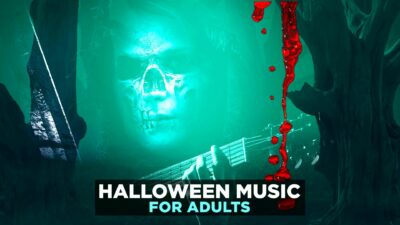

 11 Fun New Year’s Traditions (In Order Of Execution)
11 Fun New Year’s Traditions (In Order Of Execution)
wow the 1980s sound like a lot of fun
if you could survive them…